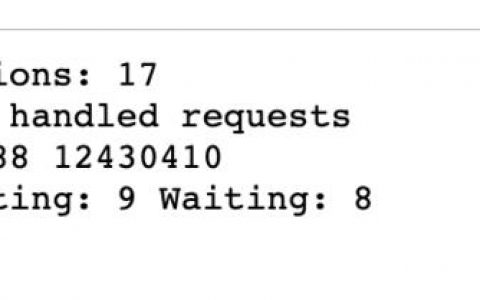Linux系统中grep命令是一种强大的文本搜索工具,它能使用正则表达式搜索文本,并把匹 配的行打印出来。grep全称是Global Regular Expression Print,表示全局正则表达式版本,它的使用权限是所有用户。
grep的工作方式是这样的,它在一个或多个文件中搜索字符串模板。如果模板包括空格,则必须被引用,模板后的所有字符串被看作文件名。搜索的结果被送到标准输出,不影响原文件内容。
grep可用于shell脚本,因为grep通过返回一个状态值来说明搜索的状态,如果模板搜索成功,则返回0,如果搜索不成功,则返回1,如果搜索的文件不存在,则返回2。我们利用这些返回值就可进行一些自动化的文本处理工作。
1.命令格式:
grep [option] pattern file
2.命令功能:
用于过滤/搜索的特定字符。可使用正则表达式能多种命令配合使用,使用上十分灵活。
3.命令参数:
-a –text #不要忽略二进制的数据。
-A<显示行数> –after-context=<显示行数> #除了显示符合范本样式的那一列之外,并显示该行之后的内容。
-b –byte-offset #在显示符合样式的那一行之前,标示出该行第一个字符的编号。
-B<显示行数> –before-context=<显示行数> #除了显示符合样式的那一行之外,并显示该行之前的内容。
-c –count #计算符合样式的列数。
-C<显示行数> –context=<显示行数>或-<显示行数> #除了显示符合样式的那一行之外,并显示该行之前后的内容。
-d <动作> -r –directories=<动作> #当指定要查找的是目录而非文件时,必须使用这项参数,否则grep指令将回报信息并停止动作。
-F –fixed-regexp #将样式视为固定字符串的列表。 查询的是文件,不是目录!
-i –ignore-case #忽略字符大小写的差别。
-r –recursive #此参数的效果和指定“-d recurse”参数相同。
-n –line-number #在显示符合样式的那一行之前,标示出该行的列数编号。
-v –revert-match #排除指定字符串。 比如查找不要#注释行开头的内容,可以用grep -v ^# /etc/keepalived.conf
-o 只显示具体grep参数的内容,不显示其他。(方便查看最好设置alias grep=grep –color)
-E –extended-regexp #将样式为延伸的普通表示法来使用。
-f<规则文件> –file=<规则文件> #指定规则文件,其内容含有一个或多个规则样式,让grep查找符合规则条件的文件内容,格式为每行一个规则样式。
-G –basic-regexp #将样式视为普通的表示法来使用。
-h –no-filename #在显示符合样式的那一行之前,不标示该行所属的文件名称。
-H –with-filename #在显示符合样式的那一行之前,表示该行所属的文件名称。
-l –file-with-matches #列出文件内容符合指定的样式的文件名称。
-L –files-without-match #列出文件内容不符合指定的样式的文件名称。
-n –line-number #在显示符合样式的那一行之前,标示出该行的列数编号。
-q –quiet或–silent #不显示任何信息。
-s –no-messages #不显示错误信息。
-V –version #显示版本信息。
-w –word-regexp #只显示全字符合的列。
-x –line-regexp #只显示全列符合的列。
-y #此参数的效果和指定“-i”参数相同。
4.规则表达式:
grep的规则表达式:
^ #锚定行的开始 如:’^grep’匹配所有以grep开头的行。
$ #锚定行的结束 如:’grep$’匹配所有以grep结尾的行。
. #匹配一个非换行符的字符 如:’gr.p’匹配gr后接一个任意字符,然后是p。
* #匹配零个或多个先前字符 如:’*grep’匹配所有一个或多个空格后紧跟grep的行。
.* #一起用代表任意字符。
[] #匹配一个指定范围内的字符,如'[Gg]rep’匹配Grep和grep。
[^] #匹配一个不在指定范围内的字符,如:'[^A-FH-Z]rep’匹配不包含A-R和T-Z的一个字母开头,紧跟rep的行。
\(..\) #标记匹配字符,如’\(love\)’,love被标记为1。
\< #锚定单词的开始,如:’\<grep’匹配包含以grep开头的单词的行。
\> #锚定单词的结束,如’grep\>’匹配包含以grep结尾的单词的行。
x\{m\} #重复字符x,m次,如:’0\{5\}’匹配包含5个o的行。
x\{m,\} #重复字符x,至少m次,如:’o\{5,\}’匹配至少有5个o的行。
x\{m,n\} #重复字符x,至少m次,不多于n次,如:’o\{5,10\}’匹配5–10个o的行。
\w #匹配文字和数字字符,也就是[A-Za-z0-9],如:’G\w*p’匹配以G后跟零个或多个文字或数字字符,然后是p。
\W #\w的反置形式,匹配一个或多个非单词字符,如点号句号等。
\b #单词锁定符,如: ‘\bgrep\b’只匹配grep。
POSIX字符:
为了在不同国家的字符编码中保持一至,POSIX(The Portable Operating System Interface)增加了特殊的字符类,如[:alnum:]是[A-Za-z0-9]的另一个写法。要把它们放到[]号内才能成为正则表达式,如[A- Za-z0-9]或[[:alnum:]]。在linux下的grep除fgrep外,都支持POSIX的字符类。
[:alnum:] #文字数字字符
[:alpha:] #文字字符
[:digit:] #数字字符
[:graph:] #非空字符(非空格、控制字符)
[:lower:] #小写字符
[:cntrl:] #控制字符
[:print:] #非空字符(包括空格)
[:punct:] #标点符号
[:space:] #所有空白字符(新行,空格,制表符)
[:upper:] #大写字符
[:xdigit:] #十六进制数字(0-9,a-f,A-F)
5.使用实例:
实例1:查找指定进程
命令:
ps -ef|grep svn
输出:
[root@localhost ~]# ps -ef|grep svn
root 4943 1 0 Dec05 ? 00:00:00 svnserve -d -r /opt/svndata/grape/
root 16867 16838 0 19:53 pts/0 00:00:00 grep svn
[root@localhost ~]#
说明:
第一条记录是查找出的进程;第二条结果是grep进程本身,并非真正要找的进程。
实例2:查找指定进程个数
命令:
ps -ef|grep svn -c
ps -ef|grep -c svn
输出:
[root@localhost ~]# ps -ef|grep svn -c
2
[root@localhost ~]# ps -ef|grep -c svn
2
[root@localhost ~]#
说明:
实例3:从文件中读取关键词进行搜索
命令:
cat test.txt | grep -f test2.txt
输出:
[root@localhost test]# cat test.txt
hnlinux
peida.cnblogs.com
ubuntu
ubuntu linux
redhat
Redhat
linuxmint
[root@localhost test]# cat test2.txt
linux
Redhat
[root@localhost test]# cat test.txt | grep -f test2.txt
hnlinux
ubuntu linux
Redhat
linuxmint
[root@localhost test]#
说明:
输出test.txt文件中含有从test2.txt文件中读取出的关键词的内容行
实例3:从文件中读取关键词进行搜索 且显示行号
命令:
cat test.txt | grep -nf test2.txt
输出:
[root@localhost test]# cat test.txt
hnlinux
peida.cnblogs.com
ubuntu
ubuntu linux
redhat
Redhat
linuxmint
[root@localhost test]# cat test2.txt
linux
Redhat
[root@localhost test]# cat test.txt | grep -nf test2.txt
1:hnlinux
4:ubuntu linux
6:Redhat
7:linuxmint
[root@localhost test]#
说明:
输出test.txt文件中含有从test2.txt文件中读取出的关键词的内容行,并显示每一行的行号
实例5:从文件中查找关键词
命令:
grep ‘linux’ test.txt
输出:
[root@localhost test]# grep ‘linux’ test.txt
hnlinux
ubuntu linux
linuxmint
[root@localhost test]# grep -n ‘linux’ test.txt
1:hnlinux
4:ubuntu linux
7:linuxmint
[root@localhost test]#
说明:
实例6:从多个文件中查找关键词
命令:
grep ‘linux’ test.txt test2.txt
输出:
[root@localhost test]# grep -n ‘linux’ test.txt test2.txt
test.txt:1:hnlinux
test.txt:4:ubuntu linux
test.txt:7:linuxmint
test2.txt:1:linux
[root@localhost test]# grep ‘linux’ test.txt test2.txt
test.txt:hnlinux
test.txt:ubuntu linux
test.txt:linuxmint
test2.txt:linux
[root@localhost test]#
说明:
多文件时,输出查询到的信息内容行时,会把文件的命名在行最前面输出并且加上”:”作为标示符
实例7:grep不显示本身进程
命令:
ps aux|grep \[s]sh
ps aux | grep ssh | grep -v “grep”
输出:
[root@localhost test]# ps aux|grep ssh
root 2720 0.0 0.0 62656 1212 ? Ss Nov02 0:00 /usr/sbin/sshd
root 16834 0.0 0.0 88088 3288 ? Ss 19:53 0:00 sshd: root@pts/0
root 16901 0.0 0.0 61180 764 pts/0 S+ 20:31 0:00 grep ssh
[root@localhost test]# ps aux|grep \[s]sh]
[root@localhost test]# ps aux|grep \[s]sh
root 2720 0.0 0.0 62656 1212 ? Ss Nov02 0:00 /usr/sbin/sshd
root 16834 0.0 0.0 88088 3288 ? Ss 19:53 0:00 sshd: root@pts/0
[root@localhost test]# ps aux | grep ssh | grep -v “grep”
root 2720 0.0 0.0 62656 1212 ? Ss Nov02 0:00 /usr/sbin/sshd
root 16834 0.0 0.0 88088 3288 ? Ss 19:53 0:00 sshd: root@pts/0
说明:
实例8:找出已u开头的行内容
命令:
cat test.txt |grep ^u
输出:
[root@localhost test]# cat test.txt |grep ^u
ubuntu
ubuntu linux
[root@localhost test]#
说明:
实例9:输出非u开头的行内容
命令:
cat test.txt |grep ^[^u]
输出:
[root@localhost test]# cat test.txt |grep ^[^u]
hnlinux
peida.cnblogs.com
redhat
Redhat
linuxmint
[root@localhost test]#
说明:
实例10:输出以hat结尾的行内容
命令:
cat test.txt |grep hat$
输出:
[root@localhost test]# cat test.txt |grep hat$
redhat
Redhat
[root@localhost test]#
说明:
实例11:
命令:
输出:
[root@localhost test]# ifconfig eth0|grep “[0-9]\{1,3\}\.[0-9]\{1,3\}\.[0-9]\{1,3\}\.[0-9]\{1,3\}”
inet addr:192.168.120.204 Bcast:192.168.120.255 Mask:255.255.255.0
[root@localhost test]# ifconfig eth0|grep -E “([0-9]{1,3}\.){3}[0-9]”
inet addr:192.168.120.204 Bcast:192.168.120.255 Mask:255.255.255.0
[root@localhost test]#
说明:
实例12:显示包含ed或者at字符的内容行
命令:
cat test.txt |grep -E “ed|at”
输出:
[root@localhost test]# cat test.txt |grep -E “peida|com”
peida.cnblogs.com
[root@localhost test]# cat test.txt |grep -E “ed|at”
redhat
Redhat
[root@localhost test]#
说明:
实例13:显示当前目录下面以.txt 结尾的文件中的所有包含每个字符串至少有7个连续小写字符的字符串的行
命令:
grep ‘[a-z]\{7\}’ *.txt
输出:
[root@localhost test]# grep ‘[a-z]\{7\}’ *.txt
test.txt:hnlinux
test.txt:peida.cnblogs.com
test.txt:linuxmint
[root@localhost test]#
转载请注明:西数超哥博客www.ysidc.top» linux文件查找命令grep
https://www.ysidc.top 西数超哥博客,数据库,西数超哥,虚拟主机,域名注册,域名,云服务器,云主机,云建站,ysidc.top











